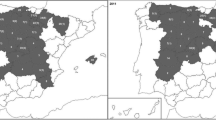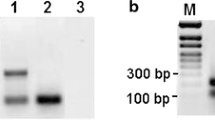Abstract
Nosema ceranae is spreading into areas where Nosema apis already exists. N. ceranae has been reported to cause an asymptomatic infection that may lead, ultimately, to colony collapse. It is thought that there may be a temperature barrier to its infiltration into countries in colder climates. In this study, 71 colonies from Scottish Beekeeper’s Association members have been screened for the presence of N. apis and N. ceranae across Scotland. We find that only 11 of the 71 colonies tested positive for spores by microscopy. However, 70.4 % of colonies screened by PCR revealed the presence of both N. ceranae and N. apis, with only 4.2 or 7 % having either strain alone and 18.3 % being Nosema free. A range of geographically separated colonies testing positive for N. ceranae were sequenced to confirm their identity. All nine sequences confirmed the presence of N. ceranae and indicated the presence of a single new variant. Furthermore, two of the spore-containing colonies had only N. ceranae present, and these exhibited the presence of smaller spores that could be distinguished from N. apis by the analysis of average spore size. Differential quantification of the PCR product revealed N. ceranae to be the dominant species in all seven samples tested. In conclusion, N. ceranae is widespread in Scotland where it exists in combination with the endemic N. apis. A single variant, identical to that found in France (DQ374655) except for the addition of a single nucleotide polymorphism, is present in Scotland.



Similar content being viewed by others
References
Aizen MA, Harder LD (2009) Geographical variation in the groowth of domesticated honey bee stocks: disease or economics? Commun Integr Biol 2:464–466
Alaux C, Ducloz F, Crauser D, Le Conte Y (2010a) Diet effects on honeybee immunocompetence. Biol Lett 6:562–565
Alaux C, Brunet JL, Dussaubat C, Mondet F, Tchamitchan S, Cousin M, Brillard J, Baldy A, Belzunces LP, Le Conte Y (2010b) Interactions between Nosema microspores and a neonicotinoid weaken honeybees (Apis mellifera). Environ Microbiol 12:774–782
Chauzat M-P, Higes M, Martin-Hernandez R, Meana A, Cougoule N, Faucon J-P (2007) Presence of Nosema ceranae in French honey bee colonies. J Apicultureal Research 46:2
Chen YP, Huang ZY (2010) Nosema ceranae, a newly identified pathogen of Apis mellifera in the USA and Asia. Apidologie 41:364–374
Chen Y, Evans DJ, zhou L, Boncristiani H, Kimura K, Xiao T, Litkowski AM, Pettis JS (2009) Asymmetrical coexistence of Nosema ceranae and Nosema apis in honey bees. J Invertebr Pathol 101:204–209
Cox-Foster DL, Conlan S, Holmes EC, Palacios G, Evans JD, Moran NA, Quan PL, Briese T, Hornig M, Geiser DM, Martinson V, vanEngelsdorp D, Kalkstein AL, Drysdale A, Hui J, Zhai J, Cui L, Hutchison SK, Simons JF, Egholm M, Pettis JS, Lipkin WI (2007) A metagenomic survey of microbes in honey bee colony collapse disorder. Science 318:283–287
Fenoy S, Rueda C, Higes M, Martin-Hernandez R, del Aguila C (2009) High-level resistance of Nosema ceranae, a parasite of the honeybee, to temperature and desiccation. Appl Environ Microbiol 75:6886–6889
Fries I (2010) Nosema ceranae in European honey bees (Apis mellifera). J Invertebr Pathol 103(Suppl 1):S73–79
Gallai N, Salles J-M, Settele J, Vaissiere B (2009) Economic valuation of the vulnerability of world agriculture confronted with pollinator decline. Ecol Econ 68:810–821
Garibaldi LAS-DI, Kremen C, Morales JM, Bommarco R, Cunningham SA, Carvalheiro LG, Chacoff NP, Dudenhöffer JH, Greenleaf SS, Holzschuh A, Isaacs R, Krewenka K, Mandelik Y, Mayfield MM, Morandin LA, Potts SG, Ricketts TH, Szentgyörgyi H, Viana BF, Westphal C, Winfree R, Klein AM (2011) Stability of pollination services decrease with isolation from natural areas despite honey bee visits. Ecol Lett 14:1062–1072
Gisder S, Hedtke K, Mockel N, Frielitz MC, Linde A, Genersch E (2010) Five-year cohort study of Nosema spp. in Germany: does climate shape virulence and assertiveness of Nosema ceranae? Appl Environ Microbiol 76:3032–3038
Higes M, Martin R, Meana A (2006) Nosema ceranae, a new microsporidian parasite in honeybees in Europe. J Invertebr Pathol 92:93–95
Higes M, Garcia-Palencia P, Martin-Hernandez R, Meana A (2007) Experimental infection of Apis mellifera honeybees with Nosema ceranae (Microsporidia). J Invertebr Pathol 94:211–217
Higes M, Martin-Hernandez R, Botias C, Bailon EG, Gonzalez-Porto AV, Barrios L, Del Nozal MJ, Bernal JL, Jimenez JJ, Palencia PG, Meana A (2008) How natural infection by Nosema ceranae causes honeybee colony collapse. Environ Microbiol 10:2659–2669
Higes M, Martin-Hernandez R, Garrido-Bailon E, Gonzalez-Porto AV, Garcia-Palencia P, Meana A, Del Nozal MJ, Mayo R, Bernal JL (2009) Honeybee colony collapse due to Nosema ceranae in professional apiaries. Environ Microbiol Rep 1:110–113
Huang WF, Bocquet M, Lee KC, Sung IH, Jiang JH, Chen YW, Wang CH (2008) The comparison of rDNA spacer regions of Nosema ceranae isolates from different hosts and locations. J Invertebr Pathol 97:9–13
Invernizzi CAC, Tomasco IH, Harriet J, Ramallo G, Campá J, Katz H, Gardiol G, Mendoza Y (2009) Presence of Nosema ceranae in honeybees (Apis mellifera) in Uruguay. J Invertebr Pathol 101:150–153
Katznelson H, Jamieson CA (1952) Control of nosema disease of honeybees with fumagillin. Science 115:70–71
Klee J, Besana AM, Genersch E, Gisder S, Nanetti A, Tam DQ, Chinh TX, Puerta F, Ruz JM, Kryger P, Message D, Hatjina F, Korpela S, Fries I, Paxton RJ (2007) Widespread dispersal of the microsporidian Nosema ceranae, an emergent pathogen of the western honey bee, Apis mellifera. J Invertebr Pathol 96:1–10
Liu TP (1988) Ultrastructural changes in Nosema apis in the midgut of the honeybee treated with thimerosal in vitro. Parasitol Res 74:492–494
Malone LA, Gatehouse HS, Tregidga EL (2001) Effects of time, temperature, and honey on Nosema apis (Microsporidia: Nosematidae), a parasite of the honeybee, Apis mellifera (Hymenoptera: Apidae). J Invertebr Pathol 77:258–268
Martin-Hernandez R, Meana A, Prieto L, Salvador AM, Garrido-Bailon E, Higes M (2007) Outcome of colonization of Apis mellifera by Nosema ceranae. Appl Environ Microbiol 73:6331–6338
Martin-Hernandez R, Meana A, Garcia-Palencia P, Marin P, Botias C, Garrido-Bailon E, Barrios L, Higes M (2009) Effect of temperature on the biotic potential of honeybee microsporidia. Appl Environ Microbiol 75:2554–2557
Mayack C, Naug D (2009) Energetic stress in the honeybee Apis mellifera from Nosema ceranae infection. J Invertebr Pathol 100:185–188
Mayack C, Naug D (2010) Parasitic infection leads to decline in hemolymph sugar levels in honeybee foragers. J Insect Physiol 56:1572–1575
Medici SK, Sarlo EG, Porrini MP, Braunstein M, Eguaras MJ (2012) Genetic variation and widespread dispersal of Nosema ceranae in Apis mellifera apiaries from Argentina. Parasitol Res 110:859–864. doi:10.1007/s00436-011-2566-2
Moore J, Jironkin A, Chandler D, Burroughs N, Evans DJ, Ryabov EV (2011) Recombinants between deformed wing virus and Varroa destructor virus-1 may prevail in Varroa destructor-infested honeybee colonies. J Gen Virol 92:156–161
Mullin CA, Frazier M, Frazier JL, Ashcraft S, Simonds R, Vanengelsdorp D, Pettis JS (2010) High levels of miticides and agrochemicals in North American apiaries: implications for honey bee health. PLoS One 5:e9754
Naug D, Gibbs A (2009) Behavioural changes mediated by hunger in honeybees infected with Nosema ceranae. Apidologie 40:595–599
O’Mahony EM, Tay WT, Paxton RJ (2007) Multiple rRNA variants in a single spore of the microsporidian Nosema bombi. J Eukaryot Microbiol 54:103–109
Paxton RJ, Klee J, Korpela S, Fries I (2007) Nosema ceranae has infected Apis mellifera in Europe since at least 1998 and may be more virulent than Nosema apis. Apidologie 38:558–565
Plischuk S, Martin-Hernandez R, Martin-Hernandez R, Prieto L, Lucia M, Lucia M, Botias C, Meana A, Abrahamovich AH, Abrahamovich AH, Lange C, Lange C, Higes M, Higes M (2009) South American native bumblebees (Hymenoptera: Apida) infected by Nosema ceranae (Microsporidia), an emerging pathogen of honeybees (Apis mellifera). Environ Microbiol Rep 1:131–135
Potts SG, Biesmeijer LC, Kremen C, Neumann P, Schweiger O, Kunin WE (2010) Global pollinator declines: trends, impacts and drivers. Trends Ecol Evol 25:345–353
Richards EH, Jones B, Bowman A (2011) Salivary secretions from the honeybee mite, Varroa destructor: effects on insect haemocytes and preliminary biochemical characterization. Parasitology 138:602–608
Stevanovic J, Stanimirovic Z, Genersch E, Kovacevic SR, Ljubenkovic J, Radakovic M, Aleksic N (2010) Dominance of Nosema ceranae in honey bees in the Balkan countries in the absence of symptoms of colony collapse disorder. Apidologie 42:49–58
Vanengelsdorp D, Vanengelsdorp D, Evans JD, Evans JD, Saegerman C, Mullin C, Mullin C, Haubruge E, Nguven BK, Nguven BK, Frazier M, Frazier M, Cox-Foster D, Chen Y, Underwood R, Tarpy DR, Pettis JS (2009) Colony collapse disorder: a descriptive study. PLoS One 4:e6481
Whitaker J, Szalananski AL, Kence M (2010) Molecular detection of Nosema ceranae and N. apis from Turkish honey bees. Apidologie 42:174–180
Williams GR, Shafer AB, Rogers RE, Shutler D, Stewart DT (2008) First detection of Nosema ceranae, a microsporidian parasite of European honey bees (Apis mellifera), in Canada and central USA. J Invertebr Pathol 97:189–192
Williams GR, Shutler D, Little CM, Burgher-MacLellan KL, Rogers REL (2010a) The microsporidian Nosema ceranae, the antibiotic Fumagilin-B®, and western honey bee (Apis mellifera) colony strength. Apidologie 42:15–22
Williams GR, Shutler D, Rogers RE (2010b) Effects at Nearctic north-temperate latitudes of indoor versus outdoor overwintering on the microsporidium Nosema ceranae and western honey bees (Apis mellifera). J Invertebr Pathol 104:4–7
Wright GA, Mustard JA, Simcock NK, Ross-Taylor AA, McNicholas LD, Popescu A, Marion-Poll F (2010) Parallel reinforcement pathways for conditioned food aversions in the honeybee. Curr Biol 20:2234–2240
Zhang Z, Schwartz S, Wagner L, Miller W (2000) A greedy algorithm for aligning DNA sequences. J Comput Biol 7:203–214
Acknowledgments
We thank the Scottish Beekeeper’s Association for their support in obtaining all the samples from their members across Scotland and the individual beekeepers participating, including Phil McAnespie, John Coyle, Alan Riach, Jim Ferguson, Helga Irvine, Ann Chilcott, Eric McArthur, and Mike Thornley. We also thank Bethany and Elaine Burch for technical assistance with the preparation of the samples. This study was supported by The Insect Pollinator Initiative (funded under the auspices of the Living with Environmental Change programme, by the Biotechnology and Biological Sciences Research Council, the Wellcome Trust, the Scottish Government, the Department for Environment, Food and Rural Affairs, and the Natural Environment Research Council (Ref. nos. BB/I00031/1 to CNC, BB/I000143/1 to GR and BB/I000178/1 to NR).
Author information
Authors and Affiliations
Corresponding author
Electronic supplementary material
Below is the link to the electronic supplementary material.
Supplementary Figure 1
Size distribution of Nosema spores identified in Scotland using larger dataset. a Samples were distributed into two groups [group A (221 spores); samples 31, 34 and 66] and [group B (171 spores); samples15, 17, 18, and 42] based on size differences determined by ANOVA (Kruskal–Wallis; Dunnett’s post hoc test) and analyzed for length, width and square area. Data were analyzed using a Mann–Whitney test (*P < 0.001). b The scatter of the length, width and square area of the spores in each sample were plotted to illustrate their size distribution. Red lines represent the average of each dataset. (DOC 339 kb). (DOC 339 kb)
Rights and permissions
About this article
Cite this article
Bollan, K.A., Hothersall, J.D., Moffat, C. et al. The microsporidian parasites Nosema ceranae and Nosema apis are widespread in honeybee (Apis mellifera) colonies across Scotland. Parasitol Res 112, 751–759 (2013). https://doi.org/10.1007/s00436-012-3195-0
Received:
Accepted:
Published:
Issue Date:
DOI: https://doi.org/10.1007/s00436-012-3195-0




